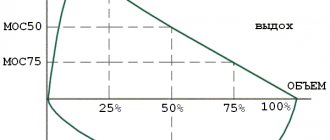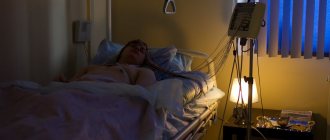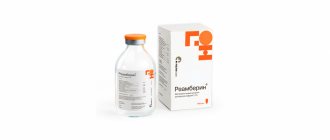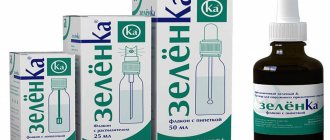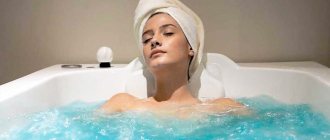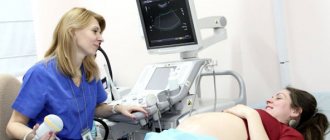To study lung volume, identify bronchial asthma and other respiratory diseases, spirometry is performed. This is a simple and painless procedure in which the patient must take several inhalations and exhalations into a special tube - a spirograph. After confirming the diagnosis, the doctor chooses the most effective treatment method.
What can spirometry determine?
Spirometry (spiro - breathing, metria - measurement) is a method that allows you to evaluate the volume of inhaled and exhaled air, as well as the speed of its passage through the respiratory tract in a calm and forced state.
With the help of this safe and painless study, possible pathologies of respiratory function and oxygen metabolism, the presence of bronchial asthma and chronic obstructive pulmonary disease are determined.
The study is carried out using a spirometer - a device for measuring the volume of air leaving the lungs during the greatest exhalation after the greatest inhalation.
Contraindications
The list of contraindications for this study is quite small. But, nevertheless, spirography should not be performed:
- after a recent heart attack or stroke ;
- for aortic aneurysm , hypertension ;
- patients with pneumothorax , bleeding ;
- if the patient has recently undergone surgery on the chest or abdomen;
- in acute heart failure .
Spirometry is included in the list of mandatory preventive examinations that must be performed annually.
Indications for spirometry
Pulmonary function testing is prescribed to:
- identify pathologies of the respiratory and cardiovascular systems;
- assess the impact of pathology of any organ or system on the function of external respiration;
- clarify or confirm the diagnosis of respiratory diseases;
- evaluate the effectiveness of the drugs used;
- identify the source of gas exchange disturbance;
- assess the level of bronchial obstruction;
- assess ability to work when working in hazardous working conditions;
- choose anesthesia method.
Spirometry reveals disturbances in the functioning of the respiratory system at the initial stages, which increases the chances of recovery.
Smokers, asthmatics and athletes are prescribed this examination on a regular basis to monitor their health and monitor the progress of treatment.
To do or not
Spirography is an accurate and informative diagnostic method. Simplicity and accessibility of use make it indispensable in assessing respiratory function. Spirography does not require special skills from the patient and the doctor; damage to the skin and infection are excluded. The procedure takes no more than 10 minutes, and the result is clinically important. Spirography also makes it possible to determine initial changes in the respiratory system, which will prevent complications in the future. Author of the article: Chekashkina Elena Nikolaevna, doctor of the highest qualification category in pediatrics, doctor of the first qualification category in neurology.
How to prepare for spirometry?
Half an hour before the start of the procedure, you need to calm down, relax and restore your breathing.
For maximum reliability of the results, the doctor may stop taking bronchodilators a day or several hours before the diagnosis.
It is also recommended to wear comfortable clothing that does not restrict movement.
The medical professional will check the patient’s height, weight and age, what medications have been taken and in what dosages recently. All this information can influence the results, and they will be taken into account when deciphering the spirogram.
Spirography: preparation
Spirography is performed in the morning, on an empty stomach, after the patient has rested for 15-20 minutes. At least one to two hours before the test, experts recommend refraining from smoking and drinking strong coffee.
Drugs that dilate the bronchi are discontinued in accordance with their therapeutic effect:
- short-acting beta-2 agonists and combination drugs are not used 6 hours before the test;
- long-acting beta-2 agonists are not used beyond 12 hours;
- Long-acting medications are not used beyond 24 hours.
The procedure is performed with the patient sitting. The height of the oral tube or seat height should be adjusted so that the patient does not have to tilt the head or excessively extend the neck. Remember that you should avoid bending your torso forward when exhaling. Clothing should not restrict the movements of the chest.
How is the spirometry procedure performed?
The patient sits in front of the spirometer. A disposable mouthpiece is attached to the device. The subject tightly clasps his lips and lightly presses the mouthpiece with his teeth. To fully record the volume and speed of inhaled and exhaled air, the medical worker applies a nose clip to the patient through an individual napkin.
The patient is explained what breathing maneuver needs to be done: maximum calm inhalation and exhalation; calm inhale and exhale as forcefully as possible, etc. Each test is performed three times. Rest between breathing maneuvers is 1 – 2 minutes.
Don't worry if you feel dizzy - this is a normal reaction that goes away after a few minutes.
Research stages
The patient's position during the procedure depends on the severity of his condition and the purpose of diagnosis. Spirography is performed standing or sitting. There are options for two approaches when the patient experiences complaints from the respiratory system when changing position. In this case, all parameters are measured first while sitting, then immediately after taking a vertical position.
Before spirography, the patient takes the required position. To prevent air loss through the nasal passages, the patient’s nostrils are clamped with a special “clothespin”.
The tube through which you need to breathe during the procedure has a mouthpiece. It also needs to be tightly wrapped around your lips so that the air comes out strictly into the apparatus and is not “lost.”
What next is required from the patient? It's simple. Spirography begins with breathing as usual, without effort. 3-5 such inhalations and exhalations are enough. Then the doctor gives a sign when you need to take the maximum possible breath, and then sharply and exhale as much as possible. After this, restore breathing as usual.
The second stage is the same 3-5 normal breathing movements. After them, the patient needs to take a deep breath, hold his breath for 1 second, and try to inhale additionally. Immediately after the second inhalation, you need to exhale as much as possible, hold your breath for 1 second and exhale as much as possible. At the end of the procedure, restore breathing.
Examination for young patients
Testing is not recommended for children under 5 years of age. Children are likely to receive unreliable spirogram data: the acquired skills do not allow them to correctly perform the necessary breathing maneuvers.
From the age of 9, a full examination is possible along with adults. Young patients should be diagnosed in specialized institutions for children.
Creating a relaxed atmosphere is the key to successful spirometry. A worker with a pedagogical approach and the use of a playful form has greater authority in the eyes of the child and will be able to carry out the procedure most effectively.
The meaning of the event and its actions are explained to the child. Thematic pictures can be used to help the child understand what is required. For example, blowing out a candle.
The specialist must pay attention to the correct execution of maneuvers and the correct sealing of the tube with the lips. The protocol reflects the number of successfully completed tests. When forming a conclusion, the patient’s age is taken into account.
Reviews
Reviews from patients who completed this study are generally good. They note that spirometry is highly informative; the procedure is not expensive, but at the same time simple and financially accessible.
- “... I went through this procedure before, during and after treatment. Each time it was clearly visible on the graph what was wrong and what was changing for the better. I did it once using Salbutamol. But, unfortunately, I was allergic to it. And the procedure itself is simple and useful.”
- “...My daughter was examined. The procedure is necessary, it is easy to undergo, does not harm the body in any way and is cheap, the result is immediately obvious. However, problems arose with the fact that my daughter coughed and could not always accurately follow the doctor’s commands. But we seem to have managed it."
- “... Spirometry was performed several times during the prof. examinations during study. Sometimes I retook the tests several times, but in the end everything turned out to be normal.”
Decoding the FVD result
There are certain norms of indicators, based on which the doctor draws conclusions.
Interpretation of the results of physical activity should take into account gender anatomical differences, age-related changes, previous diseases, and type of work activity.
Indicators will be differentiated for a healthy person and a patient. Formulas for calculating the norm are given in the table:
Table 2. Formulas for calculating normal spirometry values
| Men | |
| VC, l | 0.052 P – 0.028 B – 3.20 |
| FEV1, l | 0.036 P – 0.031 B – 1.41 |
| MVL, l/min | due vital capacity 25 |
| OOL/OEL, % | 0.33 V +16.0 |
| Women | |
| VC, l | 0.049 P – 0.019 B – 3.76 |
| FEV1, l | 0.026 P – 0.028 B – 0.36 |
| MVL, l/min | due vital capacity 25 |
| OOL/OEL, % | 0.33 B + 18.0 |
Note. When using a SG spirometer, the required FEV1 decreases in men by 0.19 l, in women – by 0.14 l. In persons aged 20 years, vital capacity and FEV are approximately 0.2 l less than at the age of 25 years; for persons over 50 years of age, the coefficient when calculating the proper international level is reduced by 2.
The norm will be individual for each person. Main spirometric parameters: FEV1, VC, FVC, FEV1/FVC. The results are analyzed based on the maximum values of FVC and FEV1.
The interpretation of the data obtained should be concise, clear, and complete. The specialist not only determines deviations of indicators from the standard value, but also evaluates the overall picture, analyzing their entirety in interrelation.
All indicators are presented below:
Table 3. Spirometry indicators
| Indicator (designation) | Norm |
| vital capacity | Actual value |
| FVC | 70-80% of vital capacity |
| District Department of Internal Affairs | 1200-1500 ml |
| ROvyd | 1000-1500 ml |
| OEL | 5000-7000 ml |
| FEV1 | > 70% FVC |
| FEV1/FVC | 75% |
| POS | > 80% of normal |
| MOS 25-75% | > 75% of normal |
| BH | 10-20 times per minute. |
The Tiffno test is informative in assessing pathological abnormalities. To understand the degree of deviation from the norm, it is customary to determine the percentage. Depending on the decrease in readings, the severity of pathological abnormalities increases.
A reading of 70% for the FEV1/FVC ratio results in significant false-positive results; a reading of 80% is also often misinterpretable in adults, but is acceptable in children. For older people (over 70 years old), some experts recommend using a value of 65%.
Carrying out the procedure with a high-quality spirometer will avoid distortions and obtain reliable readings.
Correct interpretation of the results of respiratory function helps to diagnose diseases in the early stages, prevent the development of severe forms, and determine the effectiveness of drugs in the treatment of external respiration disorders.
Properly performed spirometry, taking into account all the individual characteristics of the patient, provides comprehensive information about the state of the respiratory system. Painlessness, simplicity of the procedure, immediate results, absence of side effects are the undeniable advantages of this type of diagnosis.
